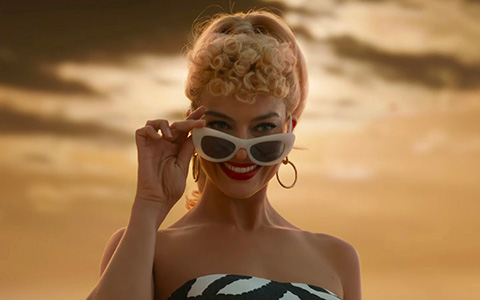3 Important Things you need to know Before Watching the Barbie Movie

Table of Contents
1. The Very First Barbie was Made in 1959
In March 1959, a doll named "Barbie" launched onto the American toy market, sporting a black-and-white striped bathing suit, pouty red lips and a sassy blonde ponytail. The leggy, 11-inch plastic figure—full name: Barbara Millicent Roberts—was the first mass-produced toy doll in the U.S. with adult features. She would go on to become one of the most iconic playthings in history.
Barbie was the brainchild of Ruth Handler, co-founder (with her husband Elliot) of the toy company Mattel, Inc. Inspired by watching their daughter play with make-believe paper dolls of adult women, Handler realized there was an unfilled niche in the market for a toy that allowed little girls to imagine the future.
Barbie’s appearance was modeled after a doll named the Bild Lilli, which had been inspired by a German comic-strip character. Originally marketed as a racy gag gift that men could buy in tobacco shops, the Lilli doll later became extremely popular with children. Mattel bought the rights to Lilli, and Handler created her own version.
Barbie from the Years 1950-2010
| Decade | The Barbie that came out during that decade |
|---|---|
| 1950s | Barbie Millicent Roberts (yes, she has a full name) debuted in 1959 as a “teenage fashion model,” representing the Old Hollywood glamour of icons like Marilyn Monroe, Audrey Hepburn and Elizabeth Taylor. She cost $3 (her outfits ranged from $1 to $5!), and 300,000 dolls were sold in the first year. |
| 1960s | With her mod look and bubble-cut hairstyle, Barbie was the grooviest doll around. More notably, in 1969 the first black Barbie doll, Christie, was introduced by Mattel. |
| 1970s | California vibes were the theme for the '70s, when Malibu Barbie (1971) and Malibu Christie (1973) ruled the sand and surf in chic one-pieces. |
| 1980s | Released in 1980, “African-American” Barbie became the first black Barbie since Christie. Five years later, Day to Night Barbie was on a mission to break through the glass ceiling as a “briefcase-carrying power executive by day” who was “date-night ready by night.” |
| 1990s | Totally Hair Barbie (1992) had blonde tresses that grazed her ankles and a neon mini that barely covered her backside. In 1999, Mattel released the Y2K-ready “Generation Girl” Barbie, who never left home without her denim jacket. |
| 2000s | Jewel Girl Barbie sported “natural-looking makeup, a more athletic physique, a bendable, flexible waist” and Barbie's first belly button! The turn of the century was huge for everyone. |
| 2010s | Those of us who played with Barbie in the '90s never got the chance to meet Raquelle — Barbie's brunette frenemy who was always trying to steal Ken and lived in her very own dream house. As for Entrepreneur Barbie (2014), she's never without her iPhone (we can relate). |
| The Next Generation | Mattel has given Barbie a 21st-century makeover as part of its 2016 #TheDollEvolves campaign. She now comes in curvy, petite and tall frames and in a variety of skin tones and hairstyles. Her closet also got a makeover — the outfit options are endless! |
2. Barbie's Controversy
Since the 1970s, Barbie has been criticized for materialism (amassing cars, houses, and clothes) and unrealistic body proportions. In fact, in 1994 researchers in Finland announced that if Barbie were a real woman, she would not have enough body fat to menstruate.
The Mental Impact of these Dolls
So we will be further diving into these categories and listing ways it can affect our mind:
- Unhealthy body image
- Contributes to unrealistic beauty standards
- Can develop into self image or esteem issues
- The children consider this toy to being the "ideal" woman and body type
- In extreme cases can lead to unhealthy dieting habits
- Not diverse enough
- Can lead to feeling inferior
- Creates a feeling of being out of place or having to morph into the "standard"
- Can make the other models feel like an afterthought and not as important
Unhealthy Body Image
It’s absolutely true that possessing one of these dolls as a child was a thing of pride and joy, but on the other hand, Barbie dolls can lead to a significant decrease in self-esteem and dissatisfaction with one’s body. Though the dolls have admirable looks and were created to empower girls to do what they want, according to research by Johnson & Wales University, the dolls have immensely unrealistic body proportions when compared to an average woman’s body.
With an estimated BMI of 16.24, a real-life Barbie would fit into the Anorexic category and would have to walk on all fours due to her body proportions, as per the ‘Get Real Barbie Campaign’ fact sheet. Many little girls consider these plastic dolls portrayed to be the ‘ideal’ young woman as their role models, leading to a series of serious issues that include extreme dieting habits, lack of body positivity and self-confidence. The actual effects of the doll seem to be far from the vision of its creator Ruth Handler
Not Diverse Enough
A typical Barbie doll is white, slim beyond reality with blonde hair and hardly any consideration for diversity in terms of bodies and beauty.
Yes, it is true that Mattel has been trying to bring out a line of diverse Barbies in terms of colour, features, body proportions and even professions, but there’s still a long road to progress. Digital artist and designer Nicolas Lamm came up with the ‘Normal Barbie’ idea and named it Lammily, which seemed to be a step in the right direction. This doll tried to represent the realistic body proportions of an average 19-year-old complete with acne, stretch marks, and other realistic skin flaws in order to show that average and realistic can be beautiful.
So, in simple terms, Barbies might not seem harmless when we’re 6-year olds but considering how our surroundings affect our development and mind, it’s important to acknowledge that Barbie dolls that portray an unrealistic standard of beauty and body size aren’t the best possible toys for kids.
3. Get to Know the Writer
Greta Gerwig, in full Greta Celeste Gerwig, (born August 4, 1983, Sacramento, California, U.S), American actress, writer, and director who was known for the radiant artlessness of her performances in small independent movies before embarking on a successful career as a filmmaker.
Her Debut as a Director
Gerwig made her highly anticipated debut as a solo writer and director with the semiautobiographical Lady Bird (2017), a coming-of-age story that focuses on the relationship between the title character (Saoirse Ronan) and her mother (Laurie Metcalf). Gerwig received Academy Award nominations for both her screenplay and her direction, and the movie was nominated for best picture. Gerwig then took on Louisa May Alcott’s classic novel, Little Women. Her adaptation, which she both wrote and directed, earned rapturous reviews upon its release in 2019, and the drama received a number of Oscar nominations, including nods for best picture and adapted screenplay. Gerwig then moved in front of the camera, costarring with Adam Driver in White Noise (2022), an adaptation of Don DeLillo’s novel about a family dealing with an airborne toxic event; the film was written and directed by Baumbach.
In total, she's directed three movies:
- Lady Bird (2017)
- Little Women (2019)
- Barbie (2023)
The Underlying Theme of Feminism in her Work
Gerwig’s directorial work has become widely beloved and known for its feminist slant: in her 2019 adaptation of Little Women, for example, she made an active choice to reform the character of Amy from an infamously spoiled brat to a well rounded woman with thoughts and feelings of her own, as well as a fully fledged understanding of the socioeconomic institution of marriage.
Meaning, you should expect Barbie to be a feminist take on the doll since this was stated “Barbie was invented first,” Gerwig told Vogue as part of Robbie’s interview article. “Ken was invented after Barbie, to burnish Barbie’s position in our eyes and in the world. That kind of creation myth is the opposite of the creation myth in Genesis.”
Sign up for Newsletter
If you enjoyed this article on Barbie, make sure to sign up for future pertinent pop culture news!
